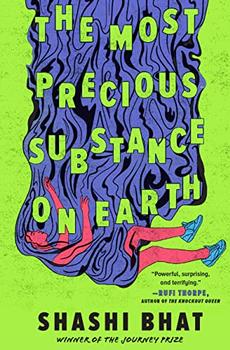Summary | Excerpt | Reviews | Beyond the Book | Read-Alikes | Genres & Themes | Author Bio

This article relates to The Most Precious Substance on Earth
Sex and the City, Girls Trip, Booksmart. Films that center female friendships feel good to watch. There is no real question as to why; these films weed out most of the realities of friendships we may not like, merge all the qualities of them we want to preserve, and play it all out in front of us, looping in a lighthearted plot to keep us engaged, so we can feel as if we, too, are a part of these fictional cliques. But where can we turn when we want to see a more nuanced take on friendship between women and girls? My answer is modern literature.

Shashi Bhat's The Most Precious Substance on Earth takes readers into a childhood friendship between characters Nina and Amy that breaks our hearts, because it reminds us of people we've known. We either knew a Nina-and-Amy or were part of a Nina-and-Amy. It seems portrayals of female friendships in contemporary literature, particularly books catered to an adult audience with some young adult appeal, tend to showcase both the good and the ugly sides. By contrast, many film depictions seem carefully curated to focus on the idyllic qualities of these relationships, using a formulaic approach: First, two girls may or may not like each other. Then, they dote relentlessly on each other, and it seems as if nothing can tear them apart. Perhaps there is one major rift, but the friends make amends and everyone lives happily ever after.
In reality, friendship dynamics change over time, and spending less time with someone does not necessarily mean you love them less. The teenage promises made with friends — that you would grow old together, perhaps have children at the same time, die together — usually do not translate to reality. That doesn't have to be sad. That doesn't mean those friendships have not made a significant impact on the person you have become today. Mourning what a friendship was, no matter how long ago or how it has shifted, is a perfectly natural experience. However, celebrating that friendship's life, vigor and passion, and accepting how it has transformed you, is just as important — maybe even more so.
Below are some novels, written between the '80s and recent years, whose portrayals of nuanced female friendships have an underestimated power that I think everyone, not just women, would benefit from paying attention to.
Grady Hendrix's My Best Friend's Exorcism centers on Abby and Gretchen, two American teenagers in the '80s who love each other unconditionally. "Dearly, but not queerly," they quip. As obstacles arrive between the two, leading up to Gretchen's need for an exorcism, readers are given to wonder if the friendship is strong enough to survive both characters changing and getting older — and whether it should.
In Sula, Toni Morrison asks, "What is friendship between women when unmediated by men?" Through the lens of childhood best friends Sula and Nel, who live opposite lifestyles in the first half of the 20th century, Morrison navigates race, class and womanhood in a patriarchal, black American neighborhood, encouraging readers to witness how these women have adapted to their circumstances. How do social expectations complicate the relationship between two women who love each other?
In Nina LaCour's We Are Okay, Marin and Mabel experience a rift in their relationship: Marin has left her old life by going to college away from her hometown, which has meant leaving childhood friend Mabel behind, too. When Mabel comes to visit Marin over winter break, Marin has to excavate feelings she's buried deep inside herself. Can Marin confront her past? Is her friendship with Mabel strong enough to survive profound grief?
Amy Tan's The Joy Luck Club, set in San Francisco, follows four immigrant Chinese mothers and their daughters' lives. The women are part of a church mahjong group called the Joy Luck Club. Throughout the narrative, the characters face various patriarchal and cultural roadblocks, but there is one constant challenge to the oppression — their willingness to look out for each other.
Zadie Smith's Swing Time follows a friendship between Tracey and the unnamed narrator. They are the only black tap dancers in their class, and a close bond blossoms between them. The two have different ideas about dance and talent, only one of them being a prodigy. Their lives diverge when the girls enter their 20s, but the novel is preoccupied with the in-betweens: How did their relationship end up the way it did? How did friends who grew up so similarly develop wildly different philosophies, determining wildly different fates?
Filed under Reading Lists
![]() This "beyond the book article" relates to The Most Precious Substance on Earth. It originally ran in August 2022 and has been updated for the
June 2023 paperback edition.
Go to magazine.
This "beyond the book article" relates to The Most Precious Substance on Earth. It originally ran in August 2022 and has been updated for the
June 2023 paperback edition.
Go to magazine.
A library is thought in cold storage
Click Here to find out who said this, as well as discovering other famous literary quotes!
Your guide toexceptional books
BookBrowse seeks out and recommends the best in contemporary fiction and nonfiction—books that not only engage and entertain but also deepen our understanding of ourselves and the world around us.